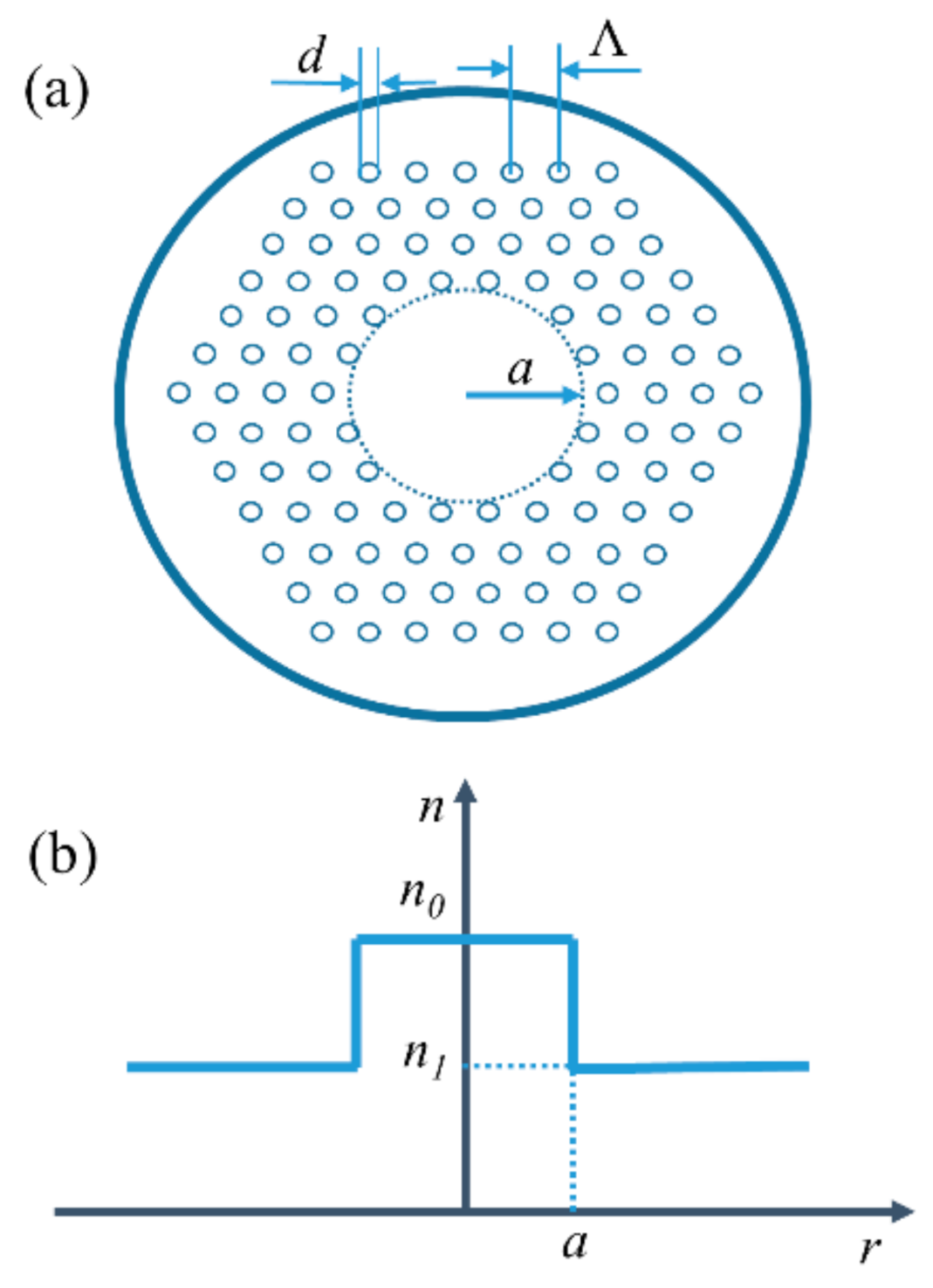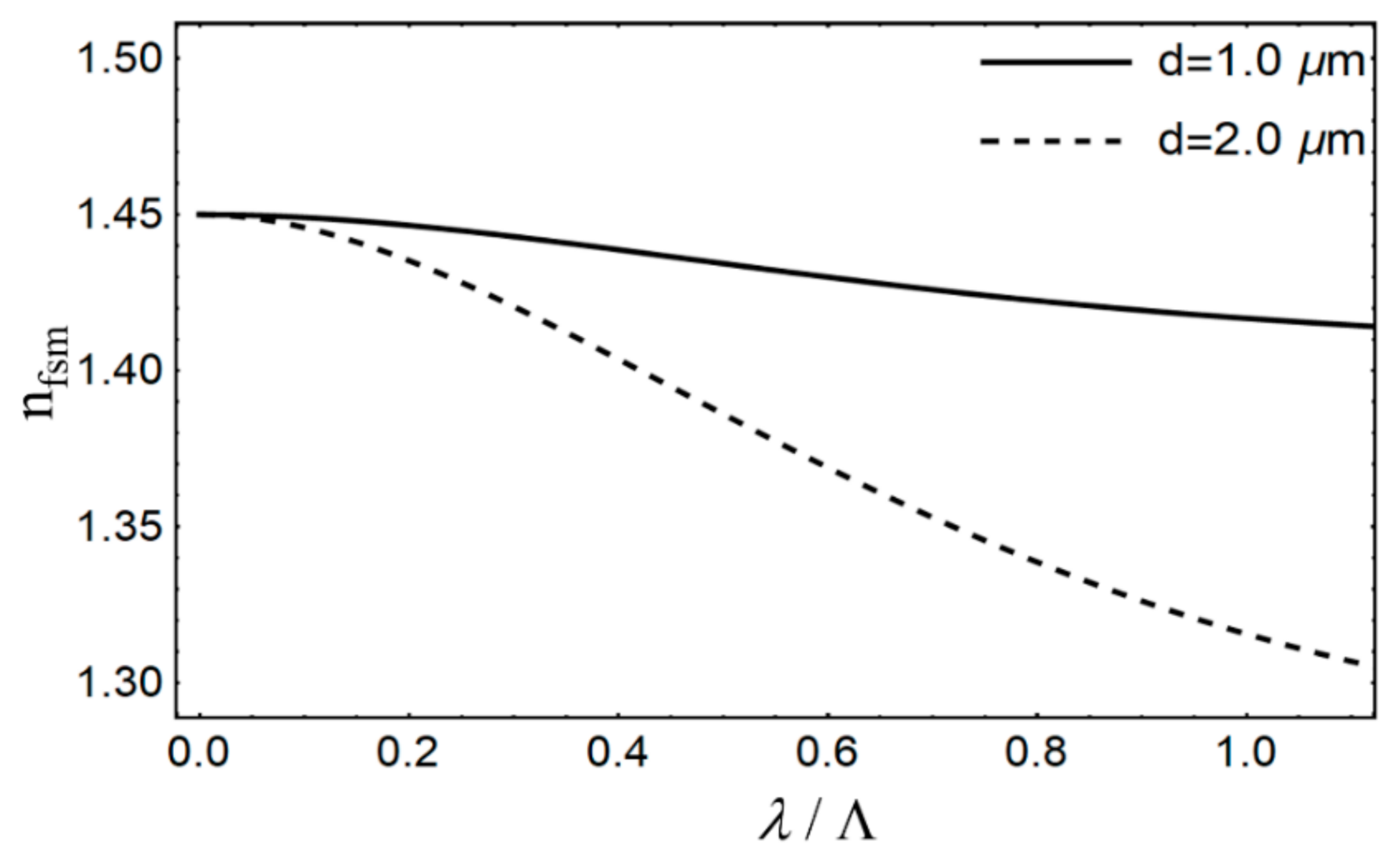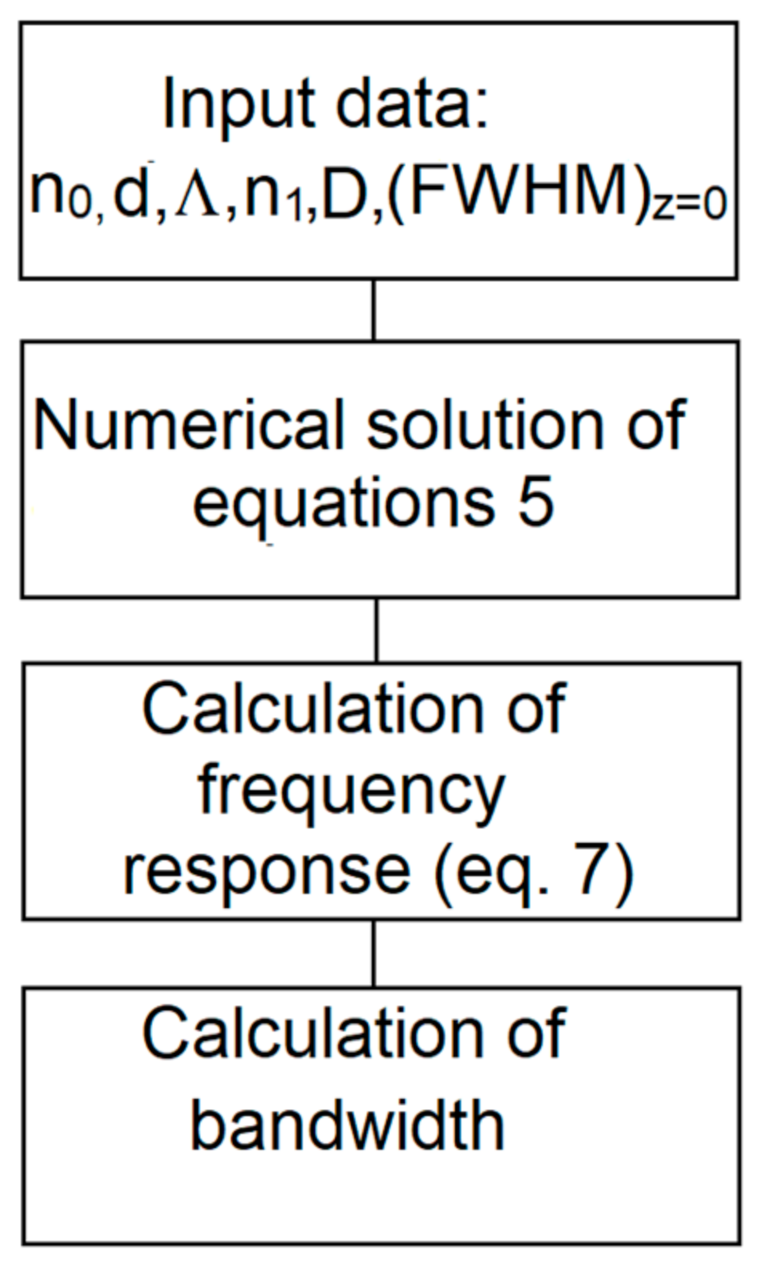Theoretical Investigation of Bandwidth in Multimode Step-Index Silica Photonic Crystal Fibers
Abstract
:1. Introduction
2. The Design of the PCF
3. The Time-Dependent PFE
4. Simulation Results
5. Conclusions
Author Contributions
Funding
Institutional Review Board Statement
Informed Consent Statement
Data Availability Statement
Conflicts of Interest
References
- Knight, J.C.; Birks, T.A.; Russell, P.S.J.; Atkin, D.M. All-silica single-mode optical fiber with photonic crystal cladding. Opt. Lett. 1996, 21, 1547–1549. [Google Scholar] [CrossRef] [PubMed]
- Birks, T.A.; Knight, J.C.; Russell, P.S.J. Endlessly single-mode photonic crystal fiber. Opt. Lett. 1997, 22, 961–963. [Google Scholar] [CrossRef] [PubMed]
- Russell, P.S.J. Photonic crystal fibers. Science 2003, 299, 358–362. [Google Scholar] [CrossRef] [PubMed]
- Knight, J.C. Photonic crystal fiber. Nature 2003, 424, 847–851. [Google Scholar] [CrossRef]
- Russell, P.S.J. Photonic-crystal fibers. J. Lightwave Technol. 2006, 24, 4729–4749. [Google Scholar] [CrossRef]
- Knight, J.C.; Broeng, J.; Birks, T.A.; Russell, P.S.J. Photonic Band Gap Guidance in Optical Fibers. Science 1998, 282, 1476–1478. [Google Scholar] [CrossRef]
- Knight, J.C.; Russell, P.S.J. Photonic crystal fibers: New way to guide light. Science 2002, 296, 276–277. [Google Scholar] [CrossRef]
- Cregan, R.F.; Mangan, B.J.; Knight, J.C.; Birks, T.A.; Russell, P.S.J.; Roberts, P.J.; Allan, D.C. Single-Mode Photonic Band Gap Guidance of Light in Air. Science 1999, 285, 1537–1539. [Google Scholar] [CrossRef] [Green Version]
- Amezcua-Correa, R.; Gèrôme, F.; Leon-Saval, S.; Broderick, N.G.R.; Birks, T.; Knight, J. Control of surface modes in low loss hollow-core photonic bandgap fibers. Opt. Express 2008, 16, 1142–1149. [Google Scholar] [CrossRef] [Green Version]
- Zhang, Z.; He, J.; Du, B.; Guo, K.; Wang, Y. Highly sensitive gas refractive index sensor based on hollow-core photonic bandgap fiber. Opt. Express 2009, 27, 29649–29658. [Google Scholar] [CrossRef]
- Zhang, X.; Gao, S.; Wang, Y.; Ding, W.; Wang, X.; Wang, P. 7-cell hollow-core photonic bandgap fiber with broad spectral bandwidth and low loss. Opt. Express 2019, 27, 11608–11616. [Google Scholar] [CrossRef]
- Benabid, F.; Knight, J.C.; Antonopoulos, G.; Russell, P.S.J. Stimulated Raman Scattering in Hydrogen-Filled Hollow-Core Photonic Crystal Fiber. Science 2002, 298, 399–402. [Google Scholar] [CrossRef]
- Light, P.; Benabid, F.; Couny, F.; Maric, M.; Luiten, A. Electromagnetically induced transparency in Rb-filled coated hollow-core photonic crystal fiber. Opt. Lett. 2007, 32, 1323–1325. [Google Scholar] [CrossRef]
- Mogilevtsev, D.; Birks, T.; Russell, P. Group-velocity dispersion in photonic crystal fibers. Opt. Lett. 1998, 23, 1662–1664. [Google Scholar] [CrossRef]
- Nair, A.A.; Amiri, I.S.; Boopathi, C.S.; Karthikumar, S.; Jayaraju, M.; Yupapin, P. Numerical investigation of co-doped microstructured fiber with two zero-dispersion wavelengths. Results Phys. 2018, 10, 766–771. [Google Scholar] [CrossRef]
- Huang, Y.; Yang, H.; Zhao, S.; Mao, Y.; Chen, S. Design of photonic crystal fibers with flat dispersion and three zero dispersion wavelengths for coherent supercontinuum generation in both normal and anomalous regions. Results Phys. 2021, 23, 104033. [Google Scholar] [CrossRef]
- Anas, T.; Asaduzzaman, S.; Ahmed, K.; Bhuiyan, T. Investigation of highly birefringent and highly nonlinear Hexa Sectored PCF with low confinement loss. Results Phys. 2018, 11, 1039–1043. [Google Scholar] [CrossRef]
- Rajesh, A.; Chandru, S.; Robinson, S. Investigation of defective hybrid cladding with silicon nanocrystal PCF for super-continuum generation. Laser Phys. 2021, 31, 126206. [Google Scholar] [CrossRef]
- Kuliesaite, M.; Jarutis, V.; Pimpe, J.; Vengelis, J. Partially coherent UV–VIS light generation in photonic crystal fiber using femtosecond pulses. Results Phys. 2021, 31, 104965. [Google Scholar] [CrossRef]
- Paul, B.K.; Moctader, M.G.; Ahmed, K.; Khalek, M.A. Nanoscale GaP strips based photonic crystal fiber with high non-linearity and high numerical aperture for laser applications. Results Phys. 2018, 10, 374–378. [Google Scholar] [CrossRef]
- Wu, D.; Guo, Z.; Wu, Z.; Shum, P. 900 nm waveband four wave mixing generation in highly nonlinear photonic crystal fiber. J. Opt. 2018, 20, 035501. [Google Scholar] [CrossRef]
- Yuan, J.; Kang, Z.; Li, F.; Zhou, G.; Sang, X.; Wu, Q.; Yan, B.; Zhou, X.; Zhong, K.; Wang, L.; et al. Polarization-dependent intermodal four-wave mixing in a birefringent multimode photonic crystal fiber. Opt. Lett. 2017, 42, 1644–1647. [Google Scholar] [CrossRef] [Green Version]
- Das, S.; De, M.; Singh, V.K. Single mode dispersion shifted photonic crystal fiber with liquid core for optofluidic applications. Opt. Fiber Technol. 2019, 53, 102012. [Google Scholar] [CrossRef]
- Monfared, Y.E.; Liang, C.; Khosravi, R.; Kacerovska, B.; Yang, S. Selectively toluene-filled photonic crystal fiber Sagnac interferometer with high sensitivity for temperature sensing applications. Results Phys. 2019, 13, 102297. [Google Scholar] [CrossRef]
- Wadsworth, W.; Percival, R.; Bouwmans, G.; Knight, J.; Birks, T.; Hedley, T.; Russell, P. Very High Numerical Aperture Fibers. IEEE Photon. Technol. Lett. 2004, 16, 843–845. [Google Scholar] [CrossRef] [Green Version]
- Hansen, K.P.; Broeng, J.; Petersson, A.; Nielsen, M.D.; Skovgaard, P.M.W.; Jakobsen, C.; Simonsen, H.R. High-power photonic crystal fibers. Proc. SPIE 2006, 6102, 61020B. [Google Scholar] [CrossRef]
- Olausson, C.B.; Hansen, K.P.; Broeng, J.; Noordegraaf, D.; Maack, M.D.; Alkeskjold, T.T.; Laurila, M.; Nikolajsen, T.; Skovgaard, P.M.W.; Sørensen, M.H.; et al. Airclad fiber laser technology. Opt. Eng. 2011, 50, 111609. [Google Scholar] [CrossRef] [Green Version]
- Stepien, R.; Siwicki, B.; Pysz, D.; Stepniewski, G.; Kujawa, I.; Klimczak, M.; Buczynski, R. Characterization of a large core photonic crystal fiber made of lead–bismuth–gallium oxide glass for broadband infrared transmission. Opt. Quantum Electron. 2014, 46, 553–561. [Google Scholar] [CrossRef] [Green Version]
- Tefelska, M.M.; Ertman, S.; Wolinski, T.R.; Mergo, P.; Dabrowski, R. Large Area Multimode Photonic Band-Gap Propagation in Photonic Liquid-Crystal Fiber. IEEE Photon. Technol. Lett. 2012, 24, 631–633. [Google Scholar] [CrossRef]
- Amitonova, L.V.; Descloux, A.; Petschulat, J.; Frosz, M.H.; Ahmed, G.; Babic, F.; Jiang, X.; Mosk, A.P.; Russell, P.; Pinkse, P.W.H. High-resolution wavefront shaping with a photonic crystal fiber for multimode fiber imaging. Opt. Lett. 2016, 41, 497–500. [Google Scholar] [CrossRef]
- Gloge, D. Optical Power Flow in Multimode Fibers. Bell Syst. Tech. J. 1972, 51, 1767–1783. [Google Scholar] [CrossRef]
- Rousseau, M.; Jeunhomme, L. Numerical Solution of the Coupled-Power Equation in Step-Index Optical Fibers. IEEE Trans. Microw. Theory Tech. 1977, 25, 577–585. [Google Scholar] [CrossRef]
- Saitoh, K.; Koshiba, M. Empirical relations for simple design of photonic crystal fibers. Opt. Express 2005, 13, 267–274. [Google Scholar] [CrossRef] [PubMed]
- Simović, A.; Drljača, B.; Savović, S.; Djordjevich, A.; Min, R. Investigation of bandwidth in multimode graded-index plastic optical fibers. Opt. Express 2021, 29, 29587–29594. [Google Scholar] [CrossRef]
- Tanaka, T.P.; Yamada, S. Steady-state characteristics of multimode W-type fibers. Appl. Opt. 1979, 18, 3261–3264. [Google Scholar] [CrossRef]
- Savović, S.; Kovačević, M.S.; Simović, A.; Kuzmanović, L.; Drljača, B.; Djordjevich, A. Method for investigation of mode coupling in multimode step-index silica photonic crystal fibers. Optik 2021, 246, 167728. [Google Scholar] [CrossRef]
- Savović, S.; Drljača, B.; Kovačević, M.S.; Djordjevich, A.; Bajić, J.S.; Stupar, D.Z.; Stepniak, G. Frequency response and bandwidth in low NA step index plastic optical fibers. Appl. Opt. 2014, 53, 6999–7003. [Google Scholar] [CrossRef]




| 0.54808 | 0.71041 | 0.16904 | −1.52736 | |
| 5.00401 | 9.73491 | 1.85765 | 1.06745 | |
| −10.43248 | 47.41496 | 18.96849 | 1.93229 | |
| 8.22992 | −43.750962 | −42.4318 | 3.89 | |
| 5 | 1.8 | 1.7 | −0.84 | |
| 7 | 7.32 | 10 | 1.02 | |
| 9 | 22.8 | 14 | 13.4 |
| d (µm) | 1.0 | 2.0 |
|---|---|---|
| 1.443717 | 1.423679 | |
| 0.00433 | 0.01815 | |
| (deg) | 5.34 | 10.93 |
Publisher’s Note: MDPI stays neutral with regard to jurisdictional claims in published maps and institutional affiliations. |
© 2022 by the authors. Licensee MDPI, Basel, Switzerland. This article is an open access article distributed under the terms and conditions of the Creative Commons Attribution (CC BY) license (https://creativecommons.org/licenses/by/4.0/).
Share and Cite
Drljača, B.; Savović, S.; Kovačević, M.S.; Simović, A.; Kuzmanović, L.; Djordjevich, A.; Min, R. Theoretical Investigation of Bandwidth in Multimode Step-Index Silica Photonic Crystal Fibers. Photonics 2022, 9, 214. https://doi.org/10.3390/photonics9040214
Drljača B, Savović S, Kovačević MS, Simović A, Kuzmanović L, Djordjevich A, Min R. Theoretical Investigation of Bandwidth in Multimode Step-Index Silica Photonic Crystal Fibers. Photonics. 2022; 9(4):214. https://doi.org/10.3390/photonics9040214
Chicago/Turabian StyleDrljača, Branko, Svetislav Savović, Milan S. Kovačević, Ana Simović, Ljubica Kuzmanović, Alexandar Djordjevich, and Rui Min. 2022. "Theoretical Investigation of Bandwidth in Multimode Step-Index Silica Photonic Crystal Fibers" Photonics 9, no. 4: 214. https://doi.org/10.3390/photonics9040214
APA StyleDrljača, B., Savović, S., Kovačević, M. S., Simović, A., Kuzmanović, L., Djordjevich, A., & Min, R. (2022). Theoretical Investigation of Bandwidth in Multimode Step-Index Silica Photonic Crystal Fibers. Photonics, 9(4), 214. https://doi.org/10.3390/photonics9040214









